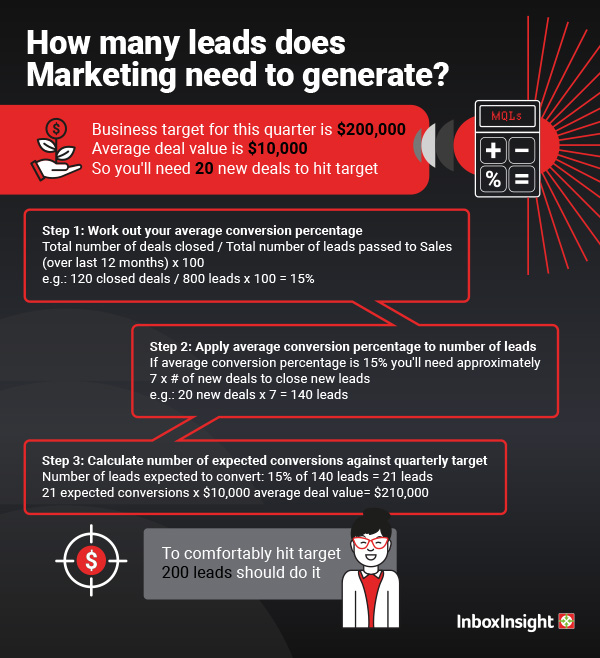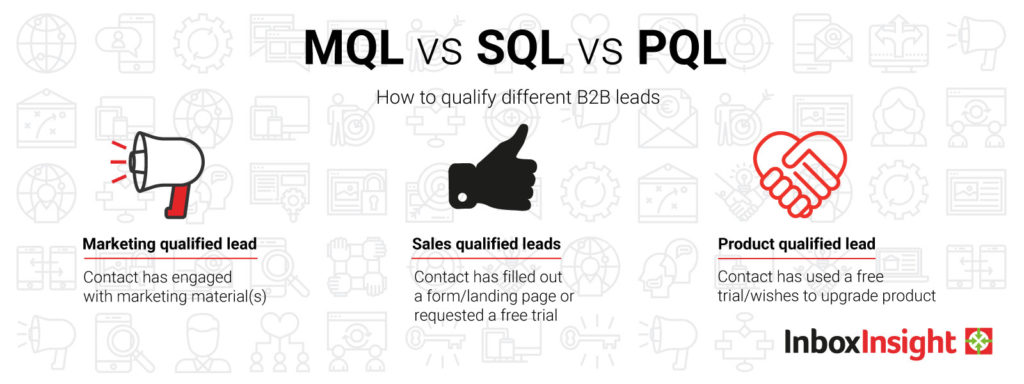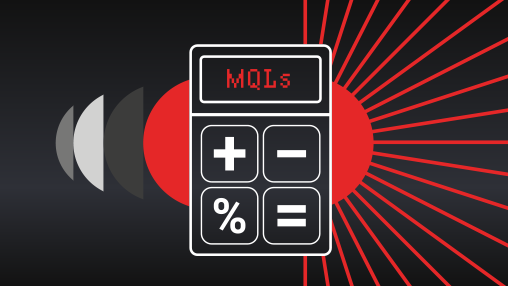Remove Guesswork with The MQL Calculator >
Simply complete the metrics below to automatically calculate the required lead volume for hitting your revenue target…
Number of leads needed
Number of new deals required
Average conversion (lead to deal)
Expected Revenue from leads
When setting out a demand generation or content marketing campaign it’s always important to start with one key question in mind – how will this bring us a return on our investment? Which essentially comes down to asking; how many leads should marketing generate?
Mapping out a path from budget spend to revenue target will help keep your campaigns on track and keep other stakeholders engaged. Profit from a demand generation campaign can be hard to measure, but it’s not impossible.
In this article we’ll explore:
- 3 key calculations for working out optimal lead volume
- The difference between the types of B2B leads you can generate
- How many marketing touches it takes to convert a lead
- 6 important lead conversion metrics
So how many leads should you be generating?
When setting up a B2B marketing campaign you’ll need to know how much you should spend to ensure you generate enough revenue from the campaign. This means, you will need to generate enough MQLs to fill your funnel and drive towards conversion.
You also need to keep a healthy number of valuable prospects flowing into the pipeline in order to get enough revenue at the end of the sales cycle.
To calculate how many leads you need to exceed your revenue goals, you need an idea of:
- Average percentage of marketing qualified leads that close into deals
- Average transaction value
- Target revenue figure
For example, imagine you are the demand generation/marketing manager of a B2B tech firm. You target decision makers within mid-market businesses and want to engage them with content discussing the benefits of your cloud software product.
Your sales team’s new business target for this quarter is $200,000
Your average deal value is $10,000 = 20 deals to hit target
Now work out the number of deals that have closed from all the leads you’ve passed to sales reps over the past year. You can use this to get an average conversion percentage.
Let’s say from a first touch with the right contact at a company that fits your criteria, 15% go right the way through to signed contracts. In that case you’ll need roughly 7 times the number of deals you need to close in new leads.
20 x 7 = 140 leads
So if 15% of 140 leads convert at our average transaction value you’ll make £210,000 and go just over target. Budget permitting, you should aim to go comfortably over this lead volume to make sure you hit your targets. In the below example, 200 leads should do nicely.

MQL vs SQL vs PQL: What’s the difference?
When it comes to filling your pipeline, it’s first important to understand the difference between the types of B2B leads you can generate and which provide the most value at different points in your pipeline.

What’s a marketing qualified lead (MQL)?
Marketing qualified leads (MQLs) are contacts who have engaged with your marketing team’s efforts but aren’t yet ready to receive a sales call. MQLs are typically identified by their level of engagement with your marketing content and campaigns. For example, if someone fills out a landing page form to download a whitepaper or access other gated content, they would be considered an MQL.
MQLs are important because they represent potential customers who have already expressed interest in your product or service. By engaging with them further, you can nurture them into becoming sales-ready leads. This is done through targeted content that speaks to their needs and interests, as well as personalized outreach from your sales team. With the right approach, you can turn MQLs into loyal customers.
What’s a sales qualified lead (SQL)?
Sales qualified leads (SQLs) are an important part of the sales process. They are contacts who have taken specific actions that indicate their interest in becoming paying customers. This could include filling out a form to ask a question about a product or service, downloading content related to the product, or signing up for a free trial.
Tagging a lead as an SQL allows sales teams to focus their efforts on prospects who are already interested in what they have to offer. It also helps them prioritize their time and resources more effectively, as they can focus on those who are most likely to convert into paying customers. It can also help sales reps better understand the needs of their prospects and tailor their approach accordingly. By understanding what motivates each individual prospect, they can create more personalized experiences that increase the likelihood of conversion.
What’s a product qualified lead (PQL)?
Product qualified leads (PQLs) are contacts who have used a product and taken actions that indicate they may be interested in becoming a paying customer. PQLs are especially beneficial for B2B companies that offer free or limited versions of their products with options to upgrade. By tracking the activities of these users, companies can identify those who are most likely to convert into paying customers.
For example, if someone is using the free version of a product but engages with features that require payment, this could be an indication they are interested in upgrading to a premium plan. B2B businesses can then use this information to target these users with special offers or discounts, increasing the chances of conversion. Additionally, tracking PQLs allows companies to better understand their user base and tailor their marketing strategy accordingly.
What percentages of leads convert into sales?
There might be multiple points of contact with a prospect along the way, including quiet periods where it’s hard to track a potential customer’s activity in your marketing software. It’s important to remember that the B2B customer could be 57-70% of the way through their buying research before they contact a sales rep, therefore it’s vital to engage the customer during their research phase, and make sure that enough of these top-of-funnel prospects are on your radar.
The lead-to-sale percentage can vary drastically from one business to another, depending on a variety of factors such as the number of new business leads you drive into your funnel, how well you qualify leads, and how good your lead-nurturing strategy is.
Therefore, it is important to ensure that you have an effective lead generation and qualification process in order to maximize your chances of converting more leads into sales.
How many marketing touches does it take to convert a lead?
The number of touches a prospect will require to convert varies depending on industry and the needs of the client. It’s thought to take anywhere between five and 10 different touch points to successfully convert a lead.
However, this process can take anywhere from one month to three months or even longer depending on whether there are more stakeholders involved in the DMU, the complexity of the product being bought, the purchase process of the potential customer and many more factors.
Instead of focusing on a quick conversion, think more about the quality of the relationship you are building. Use multiple methods – emails, phone calls, webinars, etc. – to contact each lead until they decide whether or not they want to work with you.
6 important lead conversion metrics you need to know
In order to accurately track whether or not you are successfully converting leads, there are a number of lead conversion metrics you can track:
1. Lead conversion rate
Lead conversion rate is calculated by taking the total number of closed sales or deals and dividing it by the number of marketing generated leads. The lead conversion rate helps marketers determine how well their marketing and sales teams are performing, and whether they need to adjust messaging, improve segmentation, or leverage new technologies.
2. Lead-to-sale conversion rate
The lead-to-sale conversion rate is similar to lead conversion rate but is often used by Sales to evaluate their effectiveness at converting potential customers into paying clients. Again, you can calculate the lead-to-sale conversion rate by dividing the total number of sales generated by the total number of leads in a certain time period. A high conversion rate means that your sales strategies are effectively turning leads into sales, and a low conversion rate indicates that you need to adjust your techniques to increase revenue.
3. Cost per lead
Cost per lead is a key performance indicator (KPI) measure used to assign a monetary value to user actions taken on a website such as sign-ups or purchases. The cost-per-conversion ratio calculates how much it costs a business to acquire one customer, which helps companies decide whether their digital marketing efforts are worth it. By measuring the average cost per lead, businesses can make well-informed decisions about their online strategies and optimize marketing investments while staying within budget.
4. Lead value
Lead value is a metric used to quantify the potential lost revenue that would be generated if a business did not follow up on leads quickly. It measures the cost of losing an opportunity and should motivate businesses to prioritize lead follow-up through effective funnel management. Knowing your lead value will help you understand which customers are worth pursuing, and how much you can afford to invest in lead generation campaigns. Additionally, lead value can be a useful tool for understanding when and where to focus additional resources.
5. Conversion ROI
Conversion ROI is used to measure the return on investment (ROI) of different marketing channels in terms of sales, leads, and overall conversion rate. It helps marketers track and compare the performance of each campaign across multiple channels, helping them to decide which channels are driving the most revenue and how to allocate advertising budgets effectively. By measuring conversion ROI, marketers can also optimize campaigns to increase their effectiveness and achieve higher levels of profitability.
6. Time to conversion
Time to conversion is the time it takes for a prospect to convert from a target, such as an MQL, into a customer. It is essential in helping B2B marketers measure their customer acquisition process and identify any weak spots. Having actionable insight into this metric gives businesses the ability to effectively allocate resources and create strategies that shorten their time to conversion.
By tracking these metrics, businesses can gain valuable insights into their marketing and sales strategies, allowing them to make informed decisions about how best to optimize their efforts in order to maximize conversions. Additionally, by monitoring these metrics over time, marketers can identify trends in customer behavior that can help them better understand their target audience and tailor their strategies accordingly.






